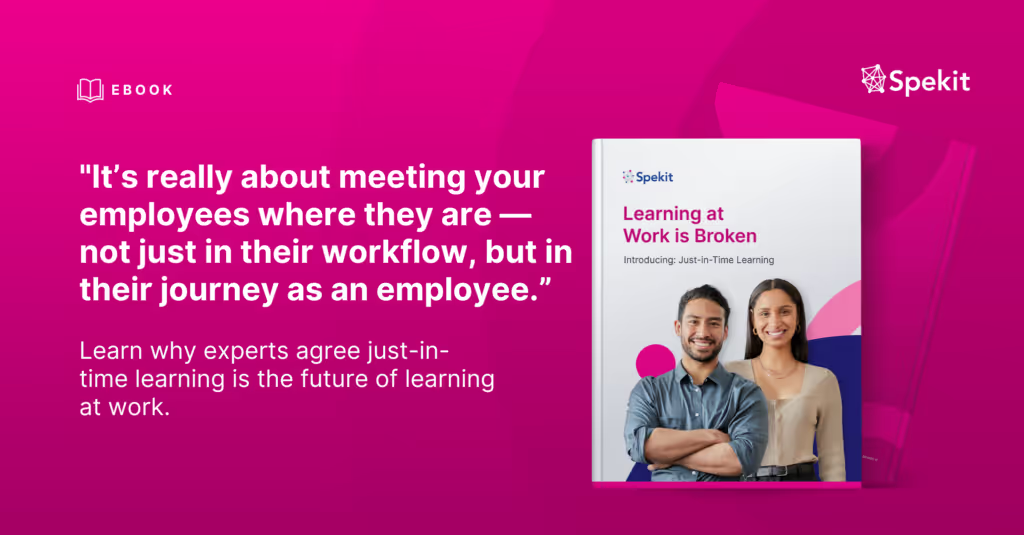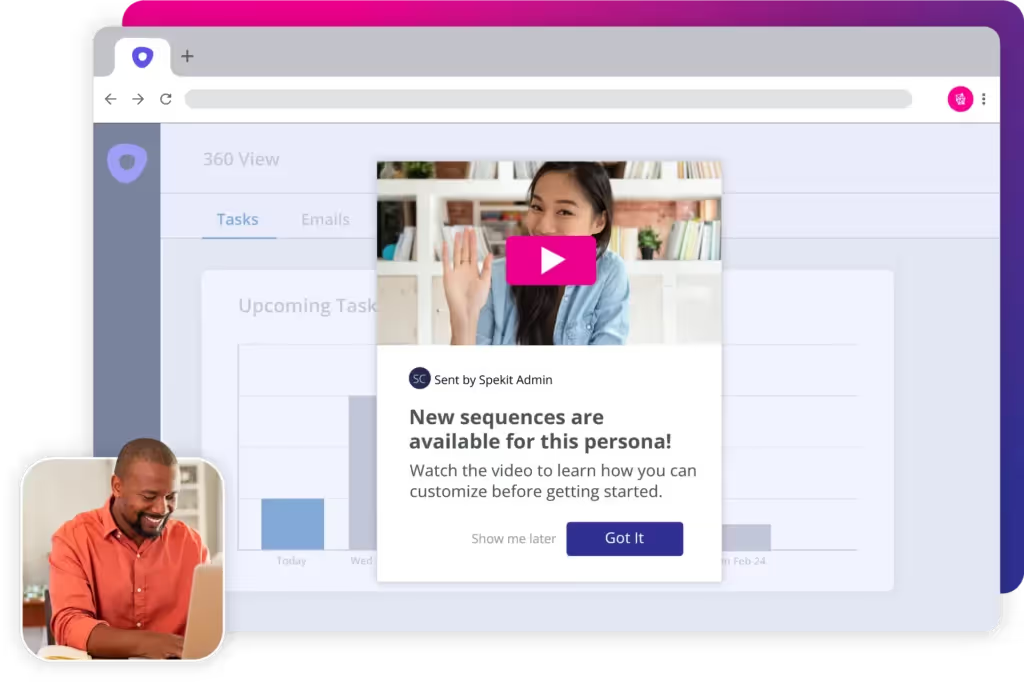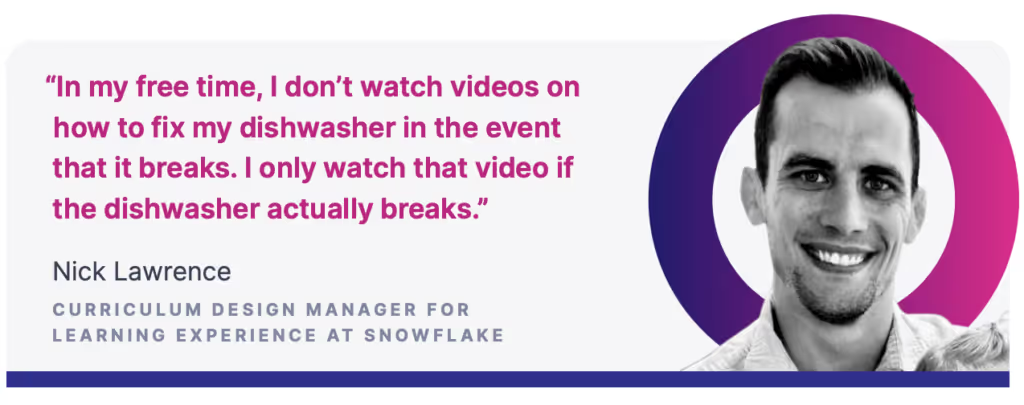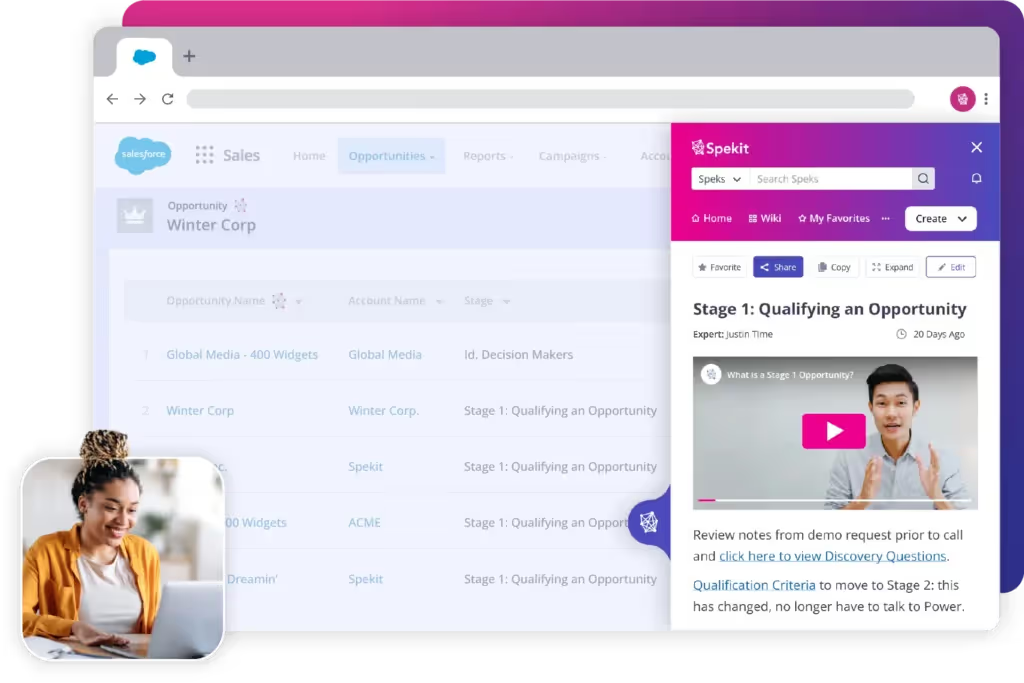Are you tired of spending countless hours creating the perfect sales process only to watch your sales reps ultimately “do their own thing?”
Is the sales process actually broken? Are your sales professionals just lazy?
The answer is likely, neither.
There’s a good chance you’ve created a compelling sales process that your reps simply struggle to understand and recall throughout the sales cycle.
So, what’s the secret? How do you help your sales reps remember crucial information?
It’s not about adding more steps to your process—it’s about embracing just-in-time learning.
Just-in-time learning transforms sales reps into productivity powerhouses by delivering precise, bite-sized knowledge right when and where it’s needed.
This overlooked key component could make all the difference between your sales process success and failure.
Buckle up as we dive into this how just-in-time learning can transform your sales process.

Go deeper: Read the eBook: Learning at work is broken. Just-in-time learning is the answer.
What is a sales process?

In the Software as a Service (SaaS) context, a sales process refers to the step-by-step approach and strategies a company follows to sell its SaaS product to customers. It outlines the various stages and activities of acquiring new customers and closing deals.
Here’s a typical sales process in SaaS, which may vary depending on the organization:
- Prospecting: The process begins with identifying potential customers who may need your SaaS product. This can involve market research, lead generation, and identifying qualified leads.
- Initial contact: Once you have identified potential prospects, the next step is to make initial contact. This can be through various channels like email, social media, phone calls, or attending industry events. The goal is to establish communication and generate interest in your SaaS solution.
- Needs assessment: In this stage, you engage with the prospect to understand their specific needs, pain points, and goals. This helps you tailor your solution and value proposition to their requirements.
- Product demonstration: Here, you showcase your SaaS product and its features to the prospect. The demonstration should highlight how your solution solves their problems and adds value to their business.
- Proposal and negotiation: Once the prospect is interested, you provide a formal proposal that outlines the pricing, terms, and conditions of your SaaS offering. Negotiations may take place to address any concerns, customize the package, or find a mutually beneficial agreement.
- Closing the deal: If both parties agree on the terms, the deal is finalized, and the prospect becomes a customer. This involves signing contracts or agreements, setting up payment terms, and any other administrative tasks required for onboarding.
- Onboarding and implementation: The customer is onboarded onto the SaaS platform after closing the deal. This includes setting up accounts, configuring the software, providing training, and ensuring a smooth transition.
- Relationship management: Once the customer uses the SaaS product, the sales process transitions into an ongoing relationship management phase. This involves customer success, support, and upselling or cross-selling opportunities to expand customer usage and maximize satisfaction.
- Renewals and upsells: As the initial subscription period nears its end, the sales team engages with the customer to renew their contract. Additionally, they may identify opportunities for upselling additional features, modules, or upgrades to enhance the customer’s experience.
Throughout the sales process, it’s important to nurture relationships, address customer concerns, and provide excellent customer service to ensure customer satisfaction and retention.
The exact steps and terminology used may vary from company to company, but these stages provide a general framework for the SaaS sales process.
7 Steps to Building a Successful Sales Process
Is your sales process falling flat? Could you use a boost in revenue?
Here’s how to transform your sales process into a powerhouse of profits with our game-changing 7-step guide.
1. Begin preparation with the end in mind — what’s the desired outcome?

Don’t start your journey without knowing your destination. Determine what success looks like to you:
- More customers?
- Higher profit margins?
- Increased productivity?
- Greater market share?
- Accelerated deal velocity?
- Decreased ramp time?
Define your goals and qualification criteria and begin identifying the path to success. Look at historical patterns and make projections based on those to avoid overshooting.
The good news?
The path to get there becomes crystal clear when you know where you want to go.
And, you can always adjust as you learn and move forward.
2. Analyze your current sales process
To fix what’s broken, you need to understand what’s happening.
Analyze your current sales process—the good and the bad.
Speak to your sales reps and other departments. Shadow their day to see what they’re experiencing. Identify and collaborate with decision-makers.
Look at the most successful reps and the least effective ones:
- What are they doing differently?
- What conversations are they having that others aren’t?
- How are they handling objections?
- What strategies are the most successful sales reps employing?
- How can you implement what’s working at scale?
- How do they research the competition?
- What are the qualification criteria they’re using for outbound prospecting?
By studying every step in detail, you’ll unearth the hidden bottlenecks and inefficiencies holding you back. From there, implementing sales playbook software can help standardize workflows and ensure sales reps follow sales training best practices consistently. Once those issues are clear, you’ll be ready to tackle them head-on.
Go deeper: Unleash the potential of AI sales tools>

3. Involve stakeholders and decision-makers
Nothing great happens in a vacuum.
The best solutions are created together. Your stakeholders hold the keys to valuable insights. Include them in the process and tap into their expertise to optimize your sales strategy and sales collateral management.
Engaging your stakeholders in the sales process cultivates a collaborative environment and enhances participation.
It will also result in a strategically superior sales plan that will catapult your sales to new heights.
4. Identify and outline the steps of the sales process

Now, you can begin laying the blueprint and communication plan for your powerful new sales process.
Outline each step, from prospecting to closing the deal, for clarity and direction.
You can identify weak points and areas ripe for enhancement by mapping your sales process.
This meticulous approach can smooth out your sales workflow, reduce friction, and highlight scalable strategies—saving time and focusing sales reps’ efforts where they are most needed.
👉 Need a head start? Use this sales process template to streamline your planning.
5. Map the buyer’s journey throughout the sales process

To close more deals, you need to think like your customer. How does the process feel from their perspective?
Mapping the buyer’s journey helps you to anticipate their needs, address their concerns, and convince them that your product or service is the solution they’ve been searching for.
This empathy-driven approach will increase your conversions and strengthen customer loyalty.
Mapping the buyer’s journey alongside your sales process can illuminate discrepancies between the two, providing insights on how to align customer actions with your sales team’s activities.
6. Implementing your standardized changes
Now that you’ve done your homework, it’s time to implement your plan.
Boldly implement the standardized changes you’ve outlined, and brace yourself for a seismic shift in your sales performance.
This courageous step is the key to breaking through previous limitations and realizing your goals.
However, revamping your sales process isn’t always a walk in the park—it comes with its share of challenges.
That’s where a just-in-time learning solution like Spekit steps in. We’ll talk more about how you can incorporate this soon.
7. Test, measure and demonstrate results

Measure twice, cut once.
Begin tracking your key performance indicators to assess the effectiveness of your new sales process. Regular testing and measurement will enable you to fine-tune your strategy and profit from precision.
Spekit has built-in sales analytics to help you assess how well your sales reps adopt change.
And don’t forget to 🎉celebrate each victory along the way!
Go deeper: Explore the benefits of personalized learning paths>
Common sales process mistakes
Do you feel like your sales team is underperforming?
You might be falling victim to these all-too-common sales process mistakes.
1. Leaving the process open to interpretation and handling objections
Ambiguity alert!
Imagine playing a game without clear rules – chaos, right?
The same goes for your sales process.
Your team may fumble without defined procedures, leading to inconsistent results and missed opportunities.
2. Forgetting sales processes are always a work in progress
Think your sales process is a one-and-done deal? Think again.
Markets evolve, customers change, and trends fizzle.
So your process shouldn’t be set in stone. Regularly revising and updating keeps you ahead of the game and ensures you’re competitive.
3. Not aligning your sales plays with your sales processes
Play & process mismatch?
Your sales plays should march in perfect harmony with your sales processes.
Aligning plays and processes ensures a seamless transition from strategy to action. The outcome? Higher efficiency and more time to build relationships and close deals.
4. Leaving marketing out of the loop
Silent marketing?
Cohesion between sales and marketing can enhance lead quality, streamline communication, and drive sales.
Don’t let your sales suffer due to a lack of inter-departmental collaboration.
5. Centering the process on closing deals
Obsessed with closing deals?
While important, closing isn’t everything.
Focus on nurturing relationships and providing value to customers.
Shifting your focus can drive long-term customer loyalty and create a sustainable revenue stream.
Go deeper: Reps Share Their Biggest Blockers To Productivity, And You’re Likely Making These Same Mistakes
6. Forgetting to measure KPIs
Not tracking Key Performance Indicators (KPIs) is like driving blindfolded.
KPIs gauge your success—they guide improvements and validate strategies.
Never underestimate the power of metrics.
Go deeper: 11 Must-Measure Sales Enablement Metrics
7. Not holding sellers accountable for the sales process
A lack of accountability could be sabotaging your sales.
A loose approach could encourage your sales reps to ignore your sales process.
By fostering responsibility and having those conversations, you can boost team productivity and dedication, taking your sales professionals from good to great.
Your sales process is a pillar of business performance and profitability. Take action now, and don’t let these common missteps stifle your success.
What is just-in-time learning?

Just-in-time learning focuses on acquiring knowledge or skills precisely when needed to perform a specific task or address a particular problem.
It’s a concept that emphasizes learning in the moment of need rather than undertaking extensive training or studying in advance.
The idea behind just-in-time learning is to provide learners with the necessary information or resources at the right time and conveniently, such as through bite-sized modules, quick reference guides, video tutorials, or searchable knowledge bases.
This allows individuals to quickly access relevant information, learn specific skills, or solve immediate problems efficiently.
Here are a few key benefits of just-in-time learning:
- Targeted and specific: Just-in-time learning focuses on delivering specific knowledge or skills directly applicable to the task at hand. It eliminates the need for learners to go through extensive courses or training programs unrelated to their immediate needs.
- Time and resource efficiency: By providing information when needed, just-in-time learning minimizes the time and resources required for training. It enables learners to acquire the necessary knowledge or skills quickly without investing in lengthy training sessions or courses.
- Flexibility and accessibility: Just-in-time learning can be delivered directly within the workflow or applications your employees use with solutions like Spekit. Learners can access the information whenever and wherever they need it, promoting flexibility and accessibility.
- Problem-solving and decision-making: This approach enables individuals to address specific problems or make informed decisions by quickly accessing relevant knowledge or skill development materials. It supports real-time problem-solving and decision-making processes.
- Continuous learning: Just-in-time learning encourages a culture of continuous learning, where individuals seek knowledge and skills as needed throughout their work or daily lives. It promotes a mindset of ongoing self-improvement and adaptation to changing circumstances.
Just-in-time learning is particularly valuable in fast-paced environments or industries where knowledge and skills need to be constantly updated. It allows individuals to stay up-to-date and relevant without dedicating significant time to traditional training methods.

Overall, just-in-time learning is an agile and practical approach that helps individuals acquire the necessary knowledge or skills precisely when they need them, promoting efficiency, flexibility, and continuous improvement.
How just-in-time learning impacts your business
1. Time is money
Did you know that the average rep spends between 3-11 hours weekly just searching for answers about tools, processes, or information?
That’s almost 28% of their workweek!
Meanwhile, more than 70% of sales leaders spend four or more hours answering these questions weekly. This constant back-and-forth isn’t just tedious; it’s costing your business valuable time and money.
2. The Salesforce conundrum
On top of this, 35% of employees feel ill-equipped to use Salesforce, resulting in a storm of ad-hoc questions and precious time wasted searching for guidance.
Plus, 40% of employees find Salesforce data entry time-consuming, leading to frequent errors and inaccurate data.
The resulting frustration often disengages employees, exacerbating the problem.
But wait, there’s more!
Only with a 75% adoption can businesses see any notable improvements in quota attainment and win rates.
Why just-in-time learning is the critical missing component of your sales process

Are you tired of your sales team missing quotas?
Exhausted from answering the same questions over and over again?
Frustrated by low Salesforce adoption?
Your business might be missing—Just-in-time learning.
“The traditional training approach is all about pushing information onto you: watch this video, take this course, sit through this training. Just-in-time learning flips that script. It’s a self-serve ‘pull approach,’ where if you need an answer or you get stuck completing a process it’s going to be there, and you’re not going to have to look for it. Which we’ve found to be significantly more effective.” – Melanie Fellay
Here’s what this transformative approach to learning and development offers:
1. It avoids context switching
You wouldn’t play a soccer game wearing stilettos, would you?
Every role needs the right context. Like that, your sales reps need to be in the right context for learning. Just-in-Time learning serves knowledge when your team needs it most, without disrupting their workflow.
Deep dive: Learn what context-switching is costing your organization
2. It surfaces knowledge the flow of work (Salesforce, Slack, LinkedIn, Outreach, Chrome)
Imagine if your sales reps could learn on the go across the platforms they use daily.
With Just-in-time learning, it’s not a pipe dream—it’s reality.
Salesforce, Slack, Chrome – learning is integrated seamlessly, in the flow of work.
You don’t go to knowledge—knowledge comes to you!
3. It holds your team accountable
Who did what and when?
Just-in-Time learning isn’t just about delivery—it’s about responsibility. This strategy holds your team accountable, ensuring every member is on the right path toward their sales goals.
No more hiding behind ambiguity or unclear expectations.
4. It lets you measure what’s working and understand what’s not
Don’t just shoot in the dark.
Drive your strategy with data insights.
Just-in-Time learning allows you to measure your team’s progress, understand friction, and make informed decisions.
It’s like having a crystal ball that shows you what’s working and what’s not, so you can tweak your sales process for optimum performance.
Power just-in-time learning with Spekit

In the fast-paced world of sales, every minute counts.
Just-in-time learning is the critical missing component to supercharging your sales process. Not only does it empower your sales team, but it also drives growth, accountability, and success.
Several companies have already reaped the benefits of just-in-time learning.
Southwest Airlines reduced their time developing training materials by 60% and spent 50% less time communicating new initiatives and changes.
Mariner Wealth spent 65% less time leading live or facilitated training, while SendLane enjoyed a 69% reduction in the time it took reps to fully grasp a new tool or process.

Ready to see Spekit in action?
Don’t just take our word for it; witness the transformative power of just-in-time learning firsthand. Request a demo of Spekit today and step into the future of sales training!
Related Resources
- How We Reduced Ghosted Accounts by 23% in 2 Weeks with Spekit & Catalyst
- Mastering Change Management for Better Tool Adoption and Success
- The Effects of Context Switching are Costing You Big Time
- Sales Documentation: Benefits and Examples
- The Cost of Going Remote on Employee Productivity and Revenue – Results







